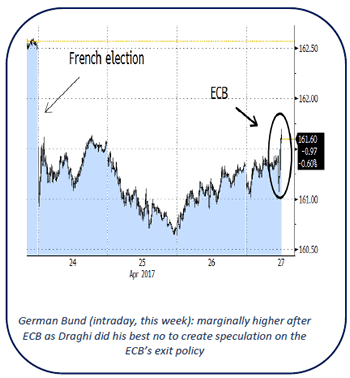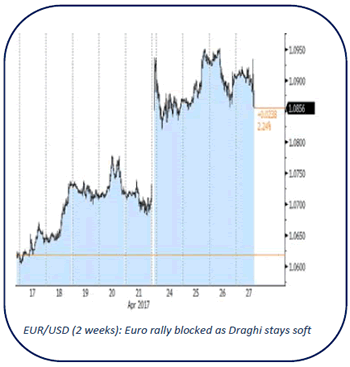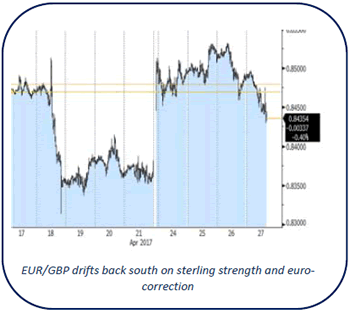Headlines
European equity markets opened significantly weaker, but managed to erase some of the losses throughout dealings. US equity markets opened slightly stronger with gains of 0.1%-0.2%
The ECB kept its monetary policy and forward guidance unchanged. For the first time, the ECB said that while risks to the economic outlook remain tilted to the downside, they are moving closely to broadly balanced. The central bank didn’t discuss changing its forward guidance or its future exit strategy.
The US Congress began moving to extend Friday’s budget deadline until May 5 and is expected to pass legislation allowing more time to finalize a spending deal to fund the federal government through September and avoid a shutdown.
Growth in durable goods orders cooled more than expected in March (from 2.3% to 0.7%) as demand for computers, machinery and fabricated metal products slid. Weekly jobless claims increased more than forecast (to 257k), but remain near historically low levels. The trade deficit widened less than predicted (to -$64.8B).
German inflation strengthened more than economists forecast in April, rebounding after an Easter-holiday related dip the previous month. German CPI accelerated to 2% Y/Y from 1.5% Y/Y the previous month, exceeding the 1.9% Y/Y forecast and hitting the ECB’s inflation target.
Economic confidence in the eurozone surpassed its pre-debt crisis peak and hit the highest level since September 2007 as the bloc’s growth prospects have been lifted by buoyant consumers and a brightening global outlook. The EC’s April economic sentiment gauge rose from 108 to 109.6 in April, ahead of forecasts (108.2).
In a surprise move, Sweden’s central bank extended its bond buying programme and slightly delayed future rate hikes despite strong domestic growth and cautious optimism about global economy activity. EUR/SEK rose from 9.55 to 9.65.
In her toughest message so far on Brexit, Ms Merkel pledged the EU would put its interests first and manage the negotiations in its chosen way. This involves dealing first with the exit bill, in defiance of Britain’s demands for the financial issues to be handled at the same time as talks on a new relationship. The order was "not reversible".
Rates
Draghi manages to avoid ECB exit speculation
European eco data released ahead of the ECB’s policy meeting confirmed the new reality the central bank has to face. EC EMU economic confidence hit the highest level in nearly a decade and German inflation rebounded in April following an Easter-related dip to hit 2%. Weakness on European stock markets and a lower oil price prevailed though, allowing the Bund to gain some ground ahead of the policy decision and Draghi’s press conference. US eco data printed mixed. Weekly jobless claims unexpectedly ticked up, but remain near historically low levels. The trade balance deficit widened less than expected.
Headline and core durable goods orders slightly disappointed, but the backward-looking proxy for the investment component in GDP growth (capital goods shipment) beat consensus. Markets ignored the US data.
The ECB decided to keep its monetary policy and forward guidance unchanged. Risks to the economic outlook remain tilted to the downside, but are moving closer to "broadly balanced". It’s the first time since very long that the ECB, unanimously, recognizes improving growth momentum. Headline inflation is expected to hover around current levels for the remainder of the year, but core inflation is only forecast to rise gradually over time. Therefore, the central bank looks through the headline number and stands ready to increase its asset purchase programme in size and/or duration if the outlook worsens. Draghi said that the central bank didn’t discuss the exit strategy or changing the forward guidance. Overall, the ECB did his utmost best today not to trigger more speculation about the start of the ECB’s normalisation process. The Bund currently trades slightly above levels recorded ahead of the meeting, erasing the downtick after Draghi said that the Eurozone economic recovery is becoming "increasingly solid".
At the time of writing, the German yield curve declines by 1.9 bps (30-yr) to 2.5 bps (2-yr). Changes on the US yield curve vary between -0.2 bps (2-yr) and +1.2 bps (30-yr). On intra-EMU bond markets, 10-yr yield spread changes versus Germany range between -4 bps (Portugal) and +2 bps (Greece).
The Italian treasury sold the on the run 5-yr BTP (€2.5B 1.2% Apr2022) and 10- yr BTP (€2.75B 2.2% Jun2027). The combined amount sold was the maximum of the €4.25-5.25B target range with a 1.45 auction bid cover, which is relatively high for Italian standards.

Currencies
Draghi stays soft, preventing further euro gains
Trading in the major cross rates entered calmer waters after the sharp swings earlier this week. The Trump tax plan didn’t provide clear guidance for the dollar. The focus for euro trading turned to the ECB’s press conference. ECB Draghi kept his balanced message. Better growth is still counterbalanced by soft underlying inflation. For now, there is no strong enough reason for FX markets to anticipate early steps to policy normalisation. EUR/USD lost marginally ground and trades in the 1.0860 area. USD/JPY trades little changed in the 111.40 area.
Overnight, the BOJ as expected left its policy unchanged. The bank was rather upbeat on the economy. Still, it cut its inflation forecast for this fiscal year, suggesting that no policy tightening is to be expected soon. The Bank expected the 2% target to be reached during the fiscal year 2018/19. The reaction of the yen was modest. USD/JPY hovered in the 111.20/25 area. Asian equities traded with limited losses following WS. EUR/USD hovered little changed in the 1.09 area.
This morning, the swings in the major cross rates were modest. Risk sentiment was slightly risk-off as investors took some further profit on this week’s equity rally The German (regional) inflation data came out on the stronger side of expectations. However, they hardly affected European yields or the single currency. Investors probably remained cautious ahead of the ECB policy decision and Draghi’s press conference. EUR/USD hovered in a very tight range close to, but mostly slightly above 1.09. USD/JPY hovered in the 111.20/40 area.
The ECB as expected left its policy and the forward guidance unchanged. EUR/USD touched an intraday low in the 1.0880 area after the ECB’s policy announcement. The ECB president indicated that the recovery is becoming more solid and as downside risks have diminished. At the same time, the underlying inflation pressures remain subdued. EUR/USD rebounded temporary to the 1.0920 area on the positive growth assessment, but the gains evaporated soon. Currency investors find it too early to positioning for further policy normalisation. EUR/USD trades again in the 1.0860 area. The US durable orders data and jobless claims were mixed to slight softer than expected but we didn’t see a sustained impact on the dollar. Risk sentiment in the US remains a bit cautious. USD/JPY is trading stable in the mid 111.50 area. For now, EUR/USD is ‘capped’ in the 1.09 area as the ECB didn’t provide enough evidence that further steps to policy normalisation will be taken.

Sterling holds strong as retail data stay strong
Sterling already received a good bid yesterday and the rebound continued today. We didn’t see any specific story behind move. Cable jumped temporary north of 1.29 and then settled near the big figure. EUR/GBP drifted back south to the 0.8450 area. At noon, the CBI reported sales were very strong at a multi month high, supported by good weather conditions. The report was sterling supportive, but sterling had already realized an important part of its intraday gains at the time of the publication of the report. In the afternoon, EUR/GBP trading joined the euro swings caused by the ECB press conference. EUR/GBP finally declined further in line with EUR/USD. The pair trades currently in the 0.8435 area. Cable is changing hands in the 1.2880 area. So, regardless of the performance of the dollar and the euro, sterling shows solid resilience.













